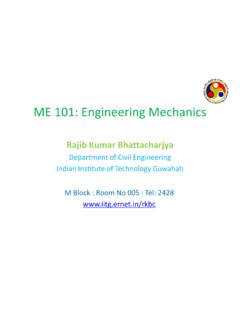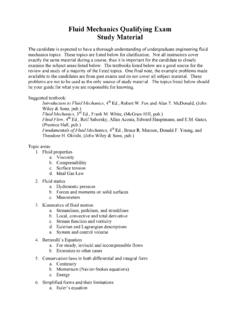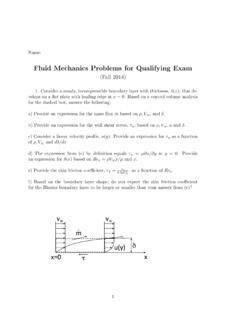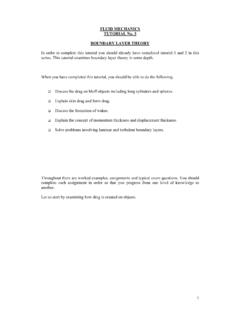Transcription of Section Two Areas of Study and Research
1 130 Study and ResearchSection TwoAreas of Study and ResearchAreas of Study and Research131 Historical SketchAEROSPACE The Guggenheim Aeronautical Laboratory, the K rm n Laboratory of fluid mechanics and Jet Propulsion, and the Firestone Flight Sciences Laboratory form the Graduate Aerospace Laboratories, widely known as GALCIT. In this complex are housed the solid mechanics , impact mechanics , and deployable space structures laboratories, the hyper-sonics and hydrodynamics facilities, the explosion dynamics and deto-nation physics laboratories, and the Joe and Edwina Charyk Laboratory of Bioinspired Design and Biopropulsion, the Center for Autonomous Systems and Technologies, as well as the various disciplines making up the broad field known as of ResearchAerospace has evolved at Caltech from a field of basic Research and engineering, primarily related to the development of the airplane, into a wide discipline encompassing a broad spectrum of basic as well as applied problems in fluid dynamics and mechanics of solids and materials and design and control of autonomous systems.
2 Educational and Research thrusts include the application of mechanics to various aspects of space exploration and to the Study of biosystems and bio-propulsion. Research at GALCIT has traditionally pioneered exploration of Areas that have anticipated subsequent technological demands. This tradition places a high premium on in-depth understanding of fields both closely and remotely related to the behavior of fluids, solids, combustion, materials, and structures, such as physics, applied and computational mathematics, dynamical systems, earthquake physics, atmospheric studies, materials science, micro- and optoelectronics, microfluidics, bioinspired design, biomedical devices, and even astro-physics. GALCIT students are known and sought after for their broad yet intense education and for their ability to deal with new and chal-lenging Areas of experimental, theoretical, and numerical Research cur-rently pursued by aerospace students at Caltech are briefly described below. mechanics of Lightweight Space Structures.
3 Current efforts in the field of next-generation deployable space structures aim to increase reliability and also lower fabrication and assembly costs by moving toward structures that consist of only a small number of separate pieces able to undergo large elastic deformations. These elastic stored-energy structures return to their original, unstressed configuration when they are released in orbit. The design of these structures requires accurate structural models that incorporate geometry change and contact effects in suf-ficient detail to capture the actual behavior that is observed in ground tests. Local and global instabilities are often observed during folding/deployment, and their effects can also be very important. Ultimately, validation against space-based experi-ments will be pursued for a selected number of structural con-figurations. In parallel to these studies, thermomechanical con-Aerospace 132 Study and Researchstitutive models for ultrathin composite materials for these novel deployable space structures are being developed.
4 Extensive studies of the deployment, elastic, and viscoelastic stability of stratospheric balloons are also being conducted. Physics of Fluids. fluid dynamics as a discipline is as much a part of physics as of engineering. Physics of fluids refers to Research in Areas closer to applied physics than to direct techni-cal applications. Present active Research includes studies in gas dynamics and hypervelocity flows, diffraction and focusing of shock waves, detonation waves, shock-induced Rayleigh-Taylor and Richtmeyer-Meshkov instabilities, transient supersonic jets, the development of laser-scattering diagnostic techniques for fluid -flow measurements, the Study of structures and mechanics in transition and turbulence, studies of two-phase flows and turbulent mixing, chemically reacting flows, and experimental manipulation and control of wall-bounded flows for improved flow characteristics, such as reduction of drag, noise, and struc-tural loading. Physics of Solids and mechanics of Materials.
5 mechanics of materials Research involves both the quasi-static and dynamic characterization of the mechanical behavior and failure of solids. In order to understand materials for applications in a wide range of structures germane to aerospace as well as other engineering disciplines, both the physical foundations of that behavior and the mathematical or numerical representation of such behavior needs to be understood. Accordingly, studies involve material response at both the macroscopic (continuum) scales and the micro- and nanoscales. Of interest are the typical engineering metals, multiphase (composite) materials, polymers and ceram-ics, thin film materials used in microelectronic and optoelectron-ic applications, soft tissue mechanics of materials, and active materials used in structural actuation and controls. Other Areas of active Research include the Study of highly nonlinear dynamics in solids, multiscale acoustic metamaterials, the analysis and design of mechanical metamaterials for the extreme conditions in air and space applications, and nondestructive evaluation/structural health monitoring of structures.
6 Space Technology. The goal of industrial utilization and explo-ration of space requires that one addresses a wide range of engineering problems. Examples of Research activities include lightweight structures for large aperture systems, in-space man-ufacturing, material and structural behavior in extreme tempera-ture and radiation environments, spacecraft shielding against hypervelocity impact threats, the mechanics of sample contain-ment for planetary protection, low-g biomechanics, biomimetics of locomotion in planetary atmospheres, hypersonic reentry into planetary atmospheres, in-space propulsion, guidance, naviga-tion and control, and launch-vehicle performance and safety. Opportunities exist for Research in collaboration with the Jet Propulsion Laboratory. Areas of Study and Research133 Historical Sketch Computational Solid mechanics . Computational solid mechanics addresses phenomena ranging from the atomistic scale, , nanostructured materials or nanoscale structures and devices, to the structural scale, , fracture of aircraft or spacecraft components, modeling of large space structures or even dynamic fragmentation phenomena accompanying hypervelocity impact.
7 It provides an indispensable tool for understanding the relation between structure and mechanical properties of materials, for predicting the efficiency of such industrial processes as machining and metal forming, and for assessing the safety of such structures as airplanes, space-craft, automobiles, and bridges. The goals and objectives of this activity are to provide a state-of-the-art environment for the development of numerical methods in solid mechanics , to provide the computational resources required for large-scale simulations in solid mechanics , and to serve as an instructional facility for advanced courses. Computational and Theoretical fluid Dynamics. Many of the fluid dynamics phenomena studied experimentally at GALCIT are also being investigated by numerical simulation and by the-oretical analysis. Present active Research Areas in computational and theoretical techniques include direct numerical simulation, particle methods for flow simulation, new algorithms and sub-grid-scale models for compressible and incompressible flows, large-eddy simulation methods, flows with shocks and driven by shocks, analytical and computational techniques for turbulence structure diagnostics, analysis of turbulent mixing dynamics, high-explosive interactions with deformable boundaries, chem-ically reacting flows, and detailed chemical reaction kinetics in flames and detonations.
8 mechanics of Fracture. An active effort is being made to understand mechanisms in a wide range of fracture problems. Aspects that are studied include quasi-static and dynamic crack growth phenomena in brittle and plastically deforming solids, polymers and advanced composites, as well as fatigue and failure of adhesive bonds. Research Areas adjunct to dynamic fracture studies are those of dynamic localization in metals and of failure in frictional interfaces. These include the Study of shear rupture phenomena in both coherent and incoherent interfaces. The dynamic failure of modern composite and layered materials and the phenomenon of earthquake rupture growth along geo-logical faults have motivated these studies. Aeronautical Engineering and Propulsion. Research in the aeronautical engineering area includes studies of airplane trailing vortices and separated flows at high angles of attack. Research work in the propulsion area has centered on the fluid dynamic problems associated with combustion, solid propellant rocket motor instabilities, fluid dynamics and optimization of scramjets, and pulse detonation engines.
9 Biomechanics of Fluids and Solids. The kinematics and dynamics of fluid flows in biological systems are studied in Aerospace 134 Study and Researchexperiments, numerical simulations, and theoretical analyses. These flows are often characterized by unsteady vortex dynam-ics, coupled fluid interactions with flexible material surfaces, non-Newtonian fluid behavior, and, in some cases, compressibil-ity. Areas of active Research include animal swimming and flying, cardiovascular fluid dynamics and hemodynamics, the mechan-ics of morphing/active deformable surfaces for flow control, and biologically inspired design of engineering systems. Technical fluid mechanics . These Areas are related to a variety of modern technological problems and, in addition, to the traditional aeronautical problems of drag, wing stall, and shear flow mixing. Additional Areas of activity include bluff-body aerodynamics, flu-id-structure interaction, turbulent combustion, laminar diffusion flames and their instabilities, explosions, hydrodynamics and two-phase flows, interaction of vorticity with free-surface, cardiac flows, swimming and flying, and active and passive control of transition and turbulence.
10 Acoustics problems studied include jet noise, com-bustion noise, and instabilities such as the generation of organ pipe oscillations in large burners of electric generating plants. fluid mechanics , Control, and Materials. The effects of boundary conditions on turbulence characteristics and general flow physics, scaling and controllability are investigated using interdisciplinary methods based on developments in materials science and control techniques. Experimental manipulation of canonical and simple model flows is used to probe fundamental issues of flow physics and control. Autonomous Systems and Technologies. Interdisciplinary Research in the expanding area of autonomous systems involves, but are not limited to, drones, robots, and spacecraft for use in science, exploration, and transportation. The Research addresses sensing, control, vision, machine learning, and other emerging Areas . Advanced drone Research , autonomous exploration, and swarm robotics will draw Research from the full range of engi-neering at Caltech, the geological and planetary sciences divi-sion, and FacilitiesThe Graduate Aerospace Laboratories contain a diversity of experi-mental facilities in support of the programs described above.








